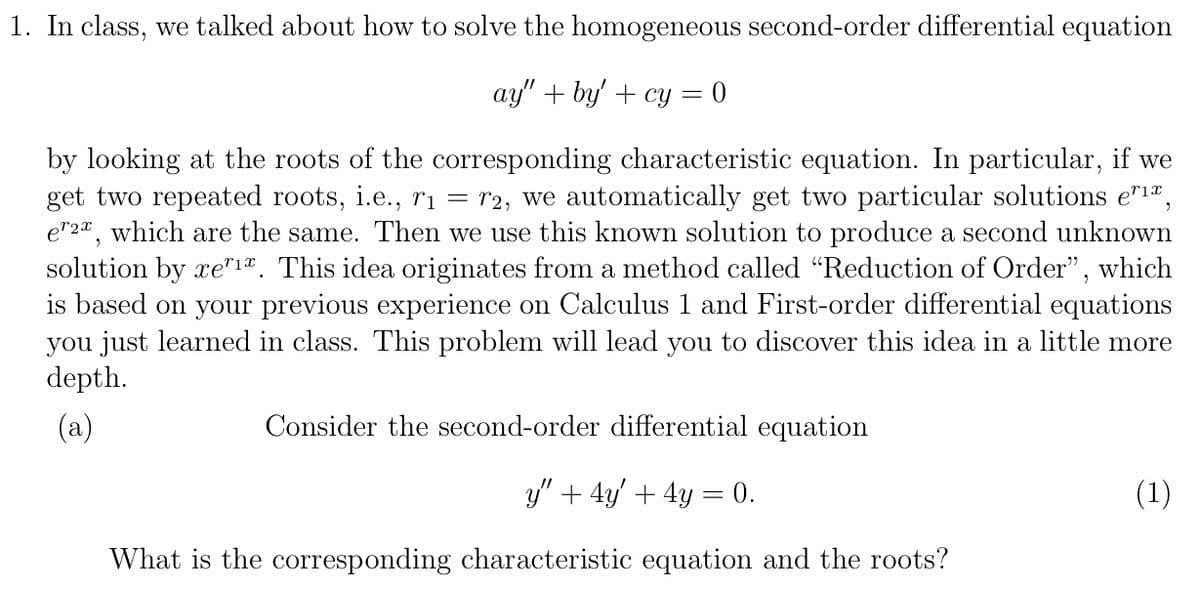1. In class, we talked about how to solve the homogeneous second-order differential equation ay" + by' + cy = 0 by looking at the roots of the corresponding characteristic equation. In particular, if we get two repeated roots, i.e., ri e"2", which are the same. Then we use this known solution to produce a second unknown solution by xe"1". This idea originates from a method called "Reduction of Order", is based on your previous experience on Calculus 1 and First-order differential equations you just learned in class. This problem will lead you to discover this idea in a little more depth. r2, we automatically get two particular solutions e"1", which (a) Consider the second-order differential equation y" + 4y' + 4y = 0. (1) What is the corresponding characteristic equation and the roots?
1. In class, we talked about how to solve the homogeneous second-order differential equation ay" + by' + cy = 0 by looking at the roots of the corresponding characteristic equation. In particular, if we get two repeated roots, i.e., ri e"2", which are the same. Then we use this known solution to produce a second unknown solution by xe"1". This idea originates from a method called "Reduction of Order", is based on your previous experience on Calculus 1 and First-order differential equations you just learned in class. This problem will lead you to discover this idea in a little more depth. r2, we automatically get two particular solutions e"1", which (a) Consider the second-order differential equation y" + 4y' + 4y = 0. (1) What is the corresponding characteristic equation and the roots?
Advanced Engineering Mathematics
10th Edition
ISBN:9780470458365
Author:Erwin Kreyszig
Publisher:Erwin Kreyszig
Chapter2: Second-order Linear Odes
Section: Chapter Questions
Problem 1RQ
Related questions
Question

Transcribed Image Text:1. In class, we talked about how to solve the homogeneous second-order differential equation
ay" + by' + cy =
by looking at the roots of the corresponding characteristic equation. In particular, if we
get two repeated roots, i.e., ri = r2, we automatically get two particular solutions e"1",
e"2", which are the same. Then we use this known solution to produce a second unknown
solution by xe"1®. This idea originates from a method called “Reduction of Order", which
is based on your previous experience on Calculus 1 and First-order differential equations
you just learned in class. This problem will lead you to discover this idea in a little more
depth.
(a)
Consider the second-order differential equation
y" + 4y' + 4y = 0.
(1)
What is the corresponding characteristic equation and the roots?

Transcribed Image Text:(b)
is also a solution of (1) by doing back substitution. Then, use Wronskian to justify
whether y1 and y2 form a fundamental set of solutions.
You are given one solution of (1), y1 = e-2t. Now verify that y2 = te-2t
Expert Solution
This question has been solved!
Explore an expertly crafted, step-by-step solution for a thorough understanding of key concepts.
Step by step
Solved in 2 steps with 3 images

Recommended textbooks for you

Advanced Engineering Mathematics
Advanced Math
ISBN:
9780470458365
Author:
Erwin Kreyszig
Publisher:
Wiley, John & Sons, Incorporated

Numerical Methods for Engineers
Advanced Math
ISBN:
9780073397924
Author:
Steven C. Chapra Dr., Raymond P. Canale
Publisher:
McGraw-Hill Education

Introductory Mathematics for Engineering Applicat…
Advanced Math
ISBN:
9781118141809
Author:
Nathan Klingbeil
Publisher:
WILEY

Advanced Engineering Mathematics
Advanced Math
ISBN:
9780470458365
Author:
Erwin Kreyszig
Publisher:
Wiley, John & Sons, Incorporated

Numerical Methods for Engineers
Advanced Math
ISBN:
9780073397924
Author:
Steven C. Chapra Dr., Raymond P. Canale
Publisher:
McGraw-Hill Education

Introductory Mathematics for Engineering Applicat…
Advanced Math
ISBN:
9781118141809
Author:
Nathan Klingbeil
Publisher:
WILEY

Mathematics For Machine Technology
Advanced Math
ISBN:
9781337798310
Author:
Peterson, John.
Publisher:
Cengage Learning,

